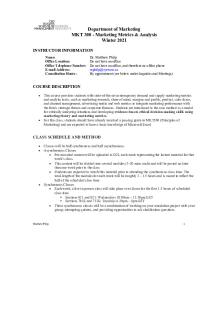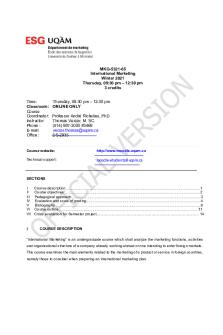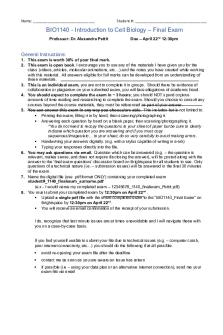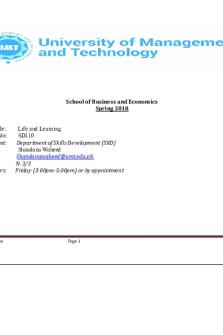MKT300Course Outline W2021 PDF

| Title | MKT300Course Outline W2021 |
|---|---|
| Course | Marketing |
| Institution | Ryerson University |
| Pages | 11 |
| File Size | 868.8 KB |
| File Type | |
| Total Downloads | 30 |
| Total Views | 189 |
Summary
Course outline...
Description
Department of Marketing MKT 300 - Marketing Metrics & Analysis Winter 2021 INSTRUCTOR INFORMATION Name: Office Location: Office Telephone Number: E-mail Address: Consultation Hours:
Dr. Matthew Philp Do not have an office Do not have an office, and therefore no office phone [email protected] By appointment (see below under Inquiries and Meetings)
COURSE DESCRIPTION •
•
This course provides students with state-of-the-art contemporary demand and supply marketing metrics and analytic tools, such as marketing research, share of mind, margins and profits, product, sales force, and channel management, advertising media and web metrics to integrate marketing performance with the firm's strategic thrusts and corporate finances. Students are introduced to the case method as a model for critically analyzing situations and developing evidence-based, ethical decision-making skills using marketing theory and marketing metrics. For this class, students should have already received a passing grade in MKT100 (Principles of Marketing) and are expected to have a basic knowledge of Microsoft Excel
CLASS SCHEDULE AND METHOD • •
•
Classes will be half synchronous and half asynchronous. Asynchronous Classes • Pre-recorded content will be uploaded to D2L each week representing the lecture material for that week’s class. • This content will be divided into several modules (5-20 mins each) and will be posted no later than one week prior to the class • Students are expected to watch this material prior to attending the synchronous class time. The total length of the modules for each week will be roughly 1 – 1.5 hours and is meant to reflect the half of the scheduled class time. Synchronous Classes • Each week, a live in-person class will take place over Zoom for the first 1.5 hours of scheduled class time § Sections 011 and 021: Wednesdays 10:00am – 11:30pm EST § Sections 701E and 711E: Tuesdays 6:30pm – 8pm EST • These synchronous classes will be a combination of working on your simulation project with your group, attempting quizzes, and providing opportunities to ask clarification questions.
Matthew Philp
1
INQUIRIES AND MEETINGS E-mail Usage & Expectations: • Students are encouraged to communicate with me by email. • Please allow up to a 24-hour reply time, excluding weekends. Students are required to activate and maintain a Ryerson e-mail account, and Faculty will not respond to student inquiries from any other e-mail address. Meetings/Consultations: • Since students have diverse schedules, any set office hours would invariably conflict with student availability and also be difficult to establish in a virtual environment. Therefore, for meetings, please contact me via email with some dates/times that work with your schedule, between 8am and 6pm and I will do my best to accommodate your requests. I will then set up a Zoom meeting once a time is established. • In addition, students are also encouraged to ask me questions during synchronous class time. Method of Posting Grades: • Quizzes and test grades will be posted on D2L. • Faculty cannot discuss final grades until they are posted on RAMMS.
TEXTS, READINGS, AND SIMULATION Text: Marketing Metrics: The Definitive Guide to Measuring Marketing Performance • https://www.vitalsource.com/products/marketing-metrics-paul-farris-v9780134086125 • 2nd edition or later should be sufficient for this course. • The text is recommended as a resource, but is not required Class notes: • Class notes will be posted on D2L for each week’s class. These notes will provide you with all the key points that will be covered in the posted lecture material and modules, as well as example questions and solutions. Supplementary Readings: • The course schedule lists some readings (see pg. 4), but others may be added to D2L during the semester. It is the students’ responsibility to check D2L on a weekly basis to ensure full class preparation. Simulation License: ~$45 USD • Once teams are formed (Week 2), the instructor will provide each team member with a link, access code, and instructions to purchase the simulation license and access the simulation.
Matthew Philp
2
EVALUATIONS Assessment
Type
Test #1 Test #2 D2L Quizzes (8 x 2% each) Team Simulation
Individual Individual Individual Groups (4-5)
TOTAL Bonus: Student Research Pool Participation
Weight 24% 30% 16% 30%
Due Dates: Week 7 Week 12 Weekly, see schedule below Weekly, see schedule below
100% Max. 2%
ASSESSMENTS – DETAILS Tests – 54%: • Test #1 (24%) will occur live during class time on Week 7 (see schedule) and will cover all material, both metrics and content, up to that point. • Test #2 (30%) will occur live during class time on the 2nd last week of class and will cover all material, both metrics and content, for the entire course. • If you miss either test for acceptable reasons (see Senate policy), and submit documentation within the specified time limit, you will be allowed to write a make-up test. Make-ups may be scheduled for weekend time slots, to avoid contact with other courses. • Tests will be multiple choice and open-book. • It is your responsibility to learn the basics of Microsoft Excel and how to use it efficiently during a test. Marketing Quizzes – 16%: • Starting in Week 2, you will have a quiz most weeks to assess your learning of the core concepts for the material covered during that week. • Quizzes will focus primarily on metrics, but may also contain content-related questions to help you prepare for Test #1 and Test #2. • Quizzes will be posted to D2L on Mondays at 12:00am EST and you will have 7 days before the quiz closes on Sundays at 11:30pm EST. • Each quiz will have a time limit to help prepare you for Test #1 and Test #2. • You will have three of attempts for each quiz, with your best score being recorded. • Each quiz will be worth 2% towards your final grade and there will be eight in total. • If you do not complete a quiz, you will earn 0 (zero) marks towards that quiz. No exceptions. Missed quizzes for any reason cannot be made up. Team Simulation – 30% • In this group project, you will work in teams of 4-5. Teams will be formed at random during synchronous class time on Week #2. • After synchronous class time on Week #2, students will be provided with a link to download and access the simulation. Each student must purchase a license for the Simulation before Week 3. Failure to do so will result in a 0% on this assignment. • As a team, you will operate a business and make decisions in a simulated environment, where you will compete with up to 6 other teams in the class. Your grade on this assignment will be based on how you perform relative to the other teams. Assessment of your performance will be based on the Simulation’s Cumulative Balanced Scorecard after your final decision. Matthew Philp
3
Rank 1st place 2nd place 3rd place 4th place 5th place th 6 place or lower No Ranking • •
• • •
•
Approximate Grade 95% 90% 85% 75% 70% 65% 0%
No Ranking: Groups that have a Cumulative Balanced Scorecard value of less than 1.0 will not be considered as ‘ranked’, and thus, will receive 0% on the simulation. If you do not log in weekly and spend sufficient time on the simulation, you will receive 0%, regardless of how your team finishes. Starting with Decision #2, you will be expected to spend a minimum of 30-45 minutes per Quarter/Decision (i.e., each week) logged into the Simulation and working. If only one person in your groups logs into the simulation, only that individual will get credit. Given the virtual nature of this course, each student within a team is expected to be logged onto the simulation and contributing to their teams’ decisions. The outline above are approximate grades. Therefore, the instructor will adjust your actual grade depending on your group and individual performance. The Simulation consists of 8 quarters of operation, with multiple decisions to be made during each quarter (see below for an outline of some of the decisions you will be required to make). Each set of decisions must be completed and submitted through the Simulation by the start of the subsequent weeks class (9am on Tuesday or Friday). If you do not submit your decisions, and this holds up the processing of the Simulation, the instructor will randomly (and not to your benefit) make those decisions for your team, and your performance will suffer. To do well in the Simulation, you will need to spend time logged into the system each week, analyzing the data and using this to develop a plan and make decisions that will earn your company the most money. Decisions by Quarter Quarter 1: Organize team to do the job. § Focus on process of working as a team to achieve goals o Assess team members' skills, personalities, and work styles o Set organizational and personal goals o Organize the work o Determine how to manage the organization o Establish leadership § Determine desired image of company o Designate a company name Quarter 2: Evaluate market opportunities, setup operations, and prepare for test market. § Analyze market opportunities—evaluate segments, geographic markets, and potential competition § Establish corporate goals and strategic direction o Specify and rank order corporate goals o Write mission statement o Select target segments o Establish strategic direction § Create customer value—design initial brands for test market
Matthew Philp
4
§
o Match components to benefits desired (Quality Function Deployment (QFD)) Select test markets—setup sales offices
Quarter 3: Go to market to test strategy, and market assumptions. § Marketing strategy—evaluate tactical options and choose marketing mix o Pricing and price promotions o Sales force management—number employed, training, and incentives o Advertising—ad copy design, media placement, and ad frequency § Market research—budget collection of information Quarter 4: Evaluate test market performance and revise strategy, become a learning organization. § Evaluate performance o Financial performance—profitability analysis o Market performance—customer opinion of brand designs, prices, advertising, and sales force o Competitor tactics—segments targeted and selection of marketing tactics § Revise marketing tactics as needed, and continue test marketing Quarter 5: Seek external funding—prepare marketing plan. § Evaluate performance—financial, marketing, and competitive § Develop two-year marketing plan o Goals—marketing and financial o Marketing strategy o Financial strategy § Invest in R&D for new technology § Begin roll out of marketing plan Quarter 6: Monitor, improve, and execute. § Evaluate performance—financial, marketing, and competitive § Skillfully adjust strategy § Marketing—make incremental changes in tactics o Use activity-based costing (ABC) to evaluate profitability of brands and sales offices o Conduct demand analysis to estimate brand, price, advertising, and sales force elasticity o Continuously improve brand features (R&D) Quarters 7 & 8: Monitor, improve, and execute (continued). § Manage strategy § Skillfully adjust strategy to unanticipated competitive moves § Continuously improve brand features (R&D), pricing, promotions, and sales force § Adjust strategy within financial capability
Matthew Philp
5
STUDENT RESEARCH POOL PARTICIPATION – UP TO 2% BONUS Students in select courses, including this class, are being given the opportunity to earn extra credit towards their final grade by participating in the Student Research Pool, as a research participant. • Maximum of 2% BONUS, per semester • Bonus can be applied to one (1) participating class, per semester • The credit cannot be used to change a failing grade to a passing grade • Bonus cannot be split across participating courses • Credits earned above 2% cannot be carried forward to the following semester To participate and earn the bonus you need to sign up for the research pool, creating an account at https://trsm-ryerson.sona-systems.com/Default.aspx?ReturnUrl=%2f. If you already have an account, you do not need to create a new one, but should set the appropriate course for your bonus. Studies are posted throughout the semester, and so you should check periodically to see what is available. • Study length will range from 15 minutes to 2 hours in length • Researchers will post the credit value for each study, based on a scale of 0.25 credits per 15 minutes of study length. In other words, to earn the full 2% will take about 2 hours. • Studies may occur online (you will need to complete the study by a certain date), or in-person, where you will need to arrive at a specified location and time. o Note: In-person studies may have higher credits per time block, at the discretion of the researcher.
Matthew Philp
6
TOPICS – TENTATIVE SEQUENCE & SCHEDULE Week Date Lecture Topic 1 Tues. – Jan 19 Review: Wed. – Jan 20 Strategic Marketing Analysis • External Environment • Porter’s 5 Forces model • SWOT • Introduce 7 P’s 2 Jan 26 Review: Jan 27 • STP • Margins and Mark-up
3
4
5 6
Feb 2 Feb 3
Feb 9 Feb 10
Feb 23 Feb 24
Review: • • • Review: • •
Break-Even Margins ROI Market Share Share of Hearts & Minds
Learning Tools Porter 5 Forces HBR Article Service marketing Chapter 1 introduction
Re-examine the common methods for segmenting, targeting and positioning a brand. Estimate size and value of segments.
Estimating Segment Size: StatsCan Euromonitor Excel Worksheets
Chapter Assessments Ch. 1
Ch. 1 Teams for Simulation (4-5 Ch. 3 people) formed, submitted to instructor via email - Simulation Starts
Quiz #1 Ch. 3 Simulation: Q1 decisions due before class start
Comprehend the relationship between Excel Worksheets pricing and channel management, and the basic metrics that inform company performance. Calculating Brand equity and brand Brand Z reports metrics Apple Brand equity Excel Worksheets
Quiz #2 Ch. 2 Simulation: Q2 decisions due before class start Quiz #3
Reading Week • Product & Portfolio Management
7
Mar 2 Mar 3
Test #1
8
Mar 9 Mar 10
• •
Matthew Philp
Learning Objectives Understand the basics of developing a particular marketing strategy, and the most common methods for organizing a company/industry analysis
Customer Profitability CLV
Relating multi-brand portfolios to STP, Excel Worksheets and exploring the complexities of cannibalization, portfolio pruning/extensions, and competition
Ch. 4 Simulation: Q3 decisions due before class start Quiz #4
Cannibalization of revenue and profits All materials from Weeks 1-6
Understanding the value of considering a consumer at a strategic, rather than transactional basis, using metrics to support/refute the costs of customer acquisition, and optimizing service provision
Using CLV to differentiate service (“The Customer Pyramid: Creating and Serving Profitable Customers”) 7
Ch. 5 Simulation: Q4 decisions due before class start Quiz #5
9
Mar 16 Mar 17
• • •
10
Mar 23 Mar 24
• •
Pricing Business Models Contribution margin and Price Elasticity Promotion Database marketing
Assessing and matching pricing strategies to brand management goals and understanding how pricing decisions tie into profits, CLV, and brand loyalty Evaluating the value and costs of loyalty programs from a sponsor and consumer perspective.
Excel Worksheets Starbucks
Ch. 7
Loyalty reports/articles Excel Worksheets
Ch. 8
Simulation: Q5 decisions due before class start Quiz #6 Simulation: Q6 decisions due before class start Quiz #7
Shift, Lift Retain
11
Mar 30 Mar 31
•
Evaluating the performance of promotional efforts through various channels, and decision tools for evaluating promotional options Advertising, Web Metrics, Applying appropriate measurement tools Excel Worksheets and Big Data for offline & online advertising
Ch. 9
Exploring data management tools (e.g., pivot tables) for big data visualization 12
Apr 6 Apr 7
Test #2
13
Apr 13
•
Apr 14
Matthew Philp
Simulation: Q7 decisions due before class start Quiz #8
Simulation: Q8 (final) decisions due before class start
Group work period – Final Simulation Decision
8
Policies and Course Practices Course Management Every effort will be made to manage the course as stated. However, adjustments may be necessary during the term at the discretion of the instructor. If so, students will be advised, and alterations will be discussed prior to implementation in class and through an announcement on D2L. Missed Classes and/or Evaluations Students are required to inform their instructors of any situation which arises during the semester which may have an adverse effect upon their academic performance, and must request any considerations and accommodations according to the relevant policies and well in advance. Failure to do so will jeopardize any academic appeals. Please see Senate Policies for specific details. • Medical certificates – If a student misses the deadline for submitting an assignment, or the date of an exam or other evaluation component because of illness, he or she must submit a Ryerson Student Medical Certificate AND an Academic Consideration form within 3 working days of the missed date. Both documents are available at www.ryerson.ca/senate/forms/medical.pdf. If you are a full-time or part-time degree student, then you submit your forms to your own program department or school. If you are a certificate or non-certificate student, then you submit your forms to the staff at the front desk of the Chang School. • Religious observance – If a student needs accommodation because of religious observance, he or she must submit a Request for Accommodation of Student Religious, Aboriginal and Spiritual Observance AND an Academic Consideration form within the first 2 weeks of the class or, for a final examination, within 2 weeks of the posting of the examination schedule. If the required absence occurs within the first 2 weeks of classes, or the dates are not known well in advance as they are linked to other conditions, these forms should be submitted with as much lead time as possible in advance of the required absence. Both documents are available at http://www.ryerson.ca/senate/forms/relobservforminstr.pdf. If you are a full-time or part-time degree student, then you submit the forms to your own program department or school. If you are a certificate or noncertificate student, then you submit the forms to the staff at the front desk of the Chang School. • Students who need academic accommodation support should register with the Academic Accommodation Support office (formerly called the Access Centre). Before the first graded work is due, registered students should inform their instructors through an “Accommodation Form for Professors” that they are registered with Academic Accommodation Support and what accommodations are required. Academic Integrity and Plagiarism Ryerson’s Policy 60 (now called the Academic Integrity policy) applies to all students at the University. The policy and its procedures are triggered in the event that the there is a suspicion that a student has engaged in a form of academic misconduct. Forms of academic misconduct include plagiarism, cheating, supplying false information to the University, and other acts. The most common form ...
Similar Free PDFs

MKT300Course Outline W2021
- 11 Pages

MKG5321 065 Course outline W2021
- 17 Pages

IMM250 Syllabus W2021
- 7 Pages

Course Syllabus-W2021
- 5 Pages

Chem205-syllabus W2021
- 6 Pages

Syllabus STAT 1060 W2021
- 7 Pages

BIO1140 Final Exam W2021 Student
- 12 Pages

Mec E301 Lab02 Digital-W2021
- 9 Pages

Outline
- 8 Pages

Outline
- 2 Pages

Outline
- 19 Pages
Popular Institutions
- Tinajero National High School - Annex
- Politeknik Caltex Riau
- Yokohama City University
- SGT University
- University of Al-Qadisiyah
- Divine Word College of Vigan
- Techniek College Rotterdam
- Universidade de Santiago
- Universiti Teknologi MARA Cawangan Johor Kampus Pasir Gudang
- Poltekkes Kemenkes Yogyakarta
- Baguio City National High School
- Colegio san marcos
- preparatoria uno
- Centro de Bachillerato Tecnológico Industrial y de Servicios No. 107
- Dalian Maritime University
- Quang Trung Secondary School
- Colegio Tecnológico en Informática
- Corporación Regional de Educación Superior
- Grupo CEDVA
- Dar Al Uloom University
- Centro de Estudios Preuniversitarios de la Universidad Nacional de Ingeniería
- 上智大学
- Aakash International School, Nuna Majara
- San Felipe Neri Catholic School
- Kang Chiao International School - New Taipei City
- Misamis Occidental National High School
- Institución Educativa Escuela Normal Juan Ladrilleros
- Kolehiyo ng Pantukan
- Batanes State College
- Instituto Continental
- Sekolah Menengah Kejuruan Kesehatan Kaltara (Tarakan)
- Colegio de La Inmaculada Concepcion - Cebu




